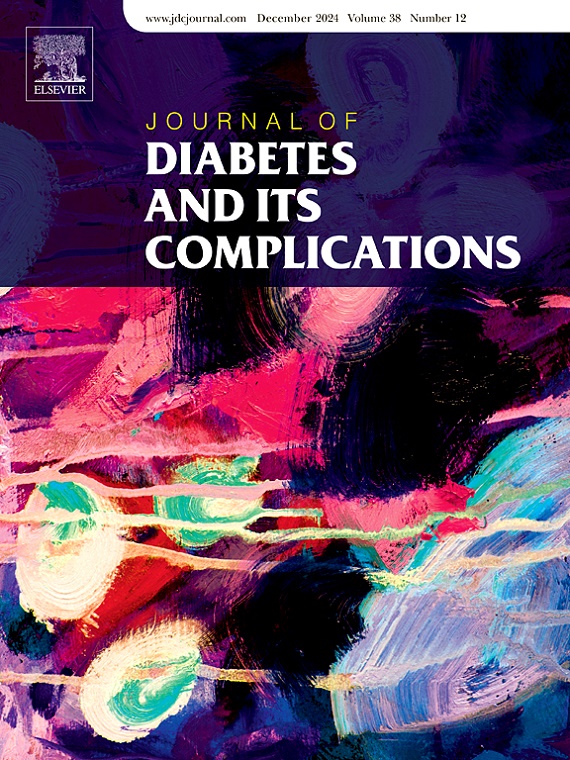DNA修复和炎症反应基因在保护长期患有1型糖尿病的患者免受血管并发症的影响中起着核心作用
IF 3.1
3区 医学
Q3 ENDOCRINOLOGY & METABOLISM
引用次数: 0
摘要
1型糖尿病(T1D)患者通常在年轻时被诊断出来,并终生暴露在高血糖中。尽管代谢控制得到改善,血管并发症的风险仍然具有挑战性。然而,有些人即使在很长一段时间后仍然没有出现严重的糖尿病并发症,即所谓的“逃避者”。本研究调查了长期T1D患者Dialong队列中与微血管并发症保护相关的转录组生物标志物。方法通过差异基因表达分析,识别无并发症的长期T1D患者(非进展者)、有血管并发症的患者(进展者)和无T1D的健康对照者之间的差异。结果在差异表达基因中,HERC2、S1PR3、RNASE3和CD33在非进展者和进展者之间有显著改变。功能注释分析确定了所有组中与翻译后蛋白修饰相关的最强机制,例如Lys-Gly异肽键参与summoylation (p = 5e-17) - SUMO(小泛素样修饰物)小蛋白的共价附着和分离以修饰蛋白质功能的生物学过程。排名第二的途径是DNA修复/损伤(p = 6e-5)、细胞周期和分裂(p = 4e-4)和免疫应答基因(p = 1e-7)的富集。结论这些发现强调了翻译后蛋白修饰、DNA修复途径和免疫耐受在保护长期T1D患者免受血管并发症的作用。本文章由计算机程序翻译,如有差异,请以英文原文为准。
DNA repair and inflammatory response genes play a central role in protecting patients with long-standing type 1 diabetes from vascular complications
Aims
Individuals with type 1 diabetes (T1D) are typically diagnosed at a young age and exposed to lifelong hyperglycaemia. Despite improved metabolic control, the risk of vascular complications remains challenging. However, some individuals remain free from developing major diabetic complications even after long duration, so-called “escapers”. This study investigated transcriptomic biomarkers linked to protection from microvascular complications in the Dialong cohort of long-standing T1D.
Methods
Differential gene expression analysis was conducted to identify differences between patients with long-term T1D without complications (non-progressors), those with vascular complications (progressors), and healthy controls without T1D.
Results
Among the differentially expressed genes, HERC2, S1PR3, RNASE3, and CD33 were significantly altered between non-progressors and progressors. Functional annotation analyses identified the strongest mechanisms across all groups to be linked to post-translational protein modification, such as Lys-Gly isopeptide bond involved in SUMOylation (p = 5e-17) - a biological process of covalent attachment and detachment of SUMO (Small Ubiquitin-like Modifier) small proteins to modify protein function. The second-ranked pathway was enrichment of DNA repair/damage (p = 6e-5), cell cycle and division (p = 4e-4), and immune response genes (p = 1e-7).
Conclusions
These findings underscore the role of post-translational protein modifications, DNA repair pathways and immune tolerance in protecting long-standing T1D patients from vascular complications.
求助全文
通过发布文献求助,成功后即可免费获取论文全文。
去求助
来源期刊

Journal of diabetes and its complications
医学-内分泌学与代谢
CiteScore
5.90
自引率
3.30%
发文量
153
审稿时长
16 days
期刊介绍:
Journal of Diabetes and Its Complications (JDC) is a journal for health care practitioners and researchers, that publishes original research about the pathogenesis, diagnosis and management of diabetes mellitus and its complications. JDC also publishes articles on physiological and molecular aspects of glucose homeostasis.
The primary purpose of JDC is to act as a source of information usable by diabetes practitioners and researchers to increase their knowledge about mechanisms of diabetes and complications development, and promote better management of people with diabetes who are at risk for those complications.
Manuscripts submitted to JDC can report any aspect of basic, translational or clinical research as well as epidemiology. Topics can range broadly from early prediabetes to late-stage complicated diabetes. Topics relevant to basic/translational reports include pancreatic islet dysfunction and insulin resistance, altered adipose tissue function in diabetes, altered neuronal control of glucose homeostasis and mechanisms of drug action. Topics relevant to diabetic complications include diabetic retinopathy, neuropathy and nephropathy; peripheral vascular disease and coronary heart disease; gastrointestinal disorders, renal failure and impotence; and hypertension and hyperlipidemia.
 求助内容:
求助内容: 应助结果提醒方式:
应助结果提醒方式:


